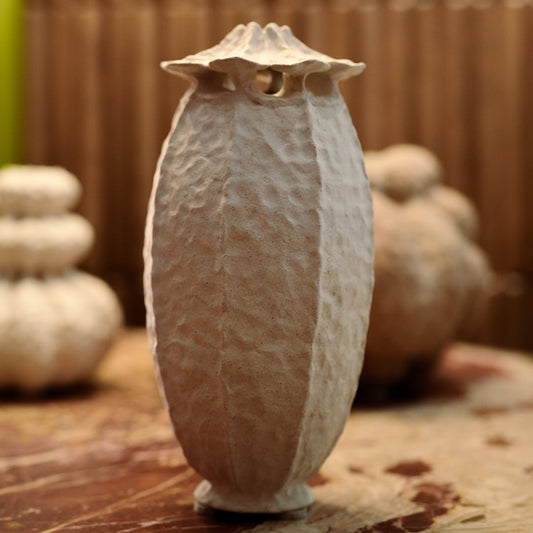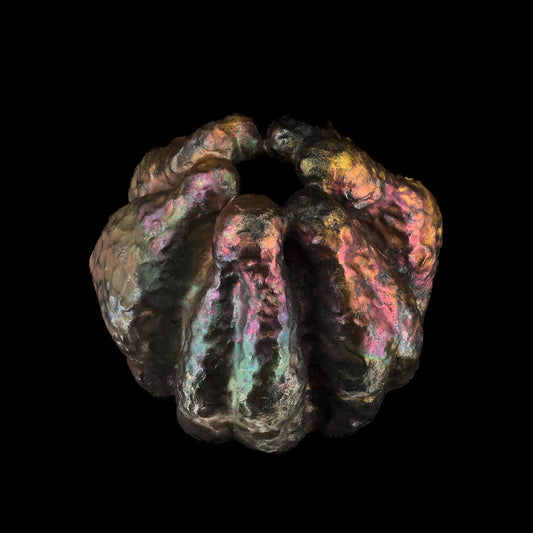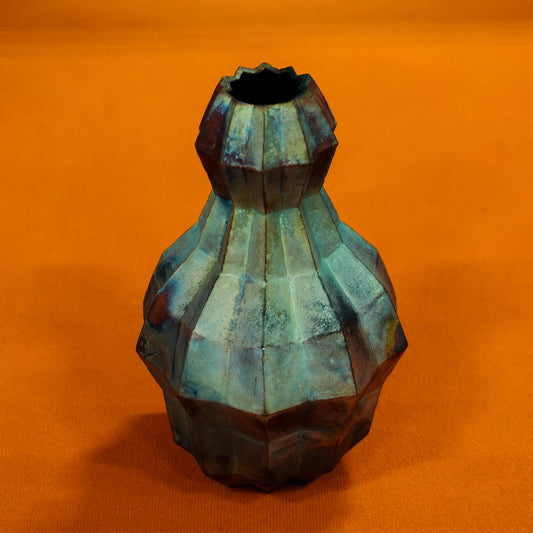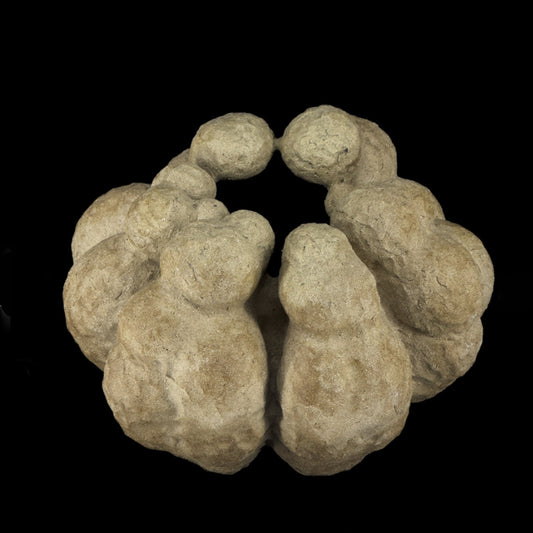ORGANIC POTTERY OF GORN CERAMICS: A SPIRITUAL JOURNEY
-
Lying deep within the bosom of the earth, clay is a naturally occurring substance formed over time through the gradual decomposition of rock. Exposure to air and water combined with fluctuations in temperature precipitate the process.
The same effect can be achieved by chemical interaction with carbon dioxide and water. When this happens, the molecular structure is broken down into tiny particles that hold water, giving them a versatility and plasticity that is ideally suited for making pottery. Finding their way to riverbanks and basins they accumulate to create deposits of rich soil from which the precious clay can be carefully extracted.
Gorn Ceramics uses a mixture of kaolin, feldspar and pegmatite for their clay which is sourced locally to reduce their carbon footprint. Kaolin, also known as China clay, after the Jiangxi Province in China, is clay in its purest form. With a soft white earthy texture, it is made from the mineral kaolinite. When moist, the clay takes on a cohesive property which facilitates moulding whilst also remaining strong enough to retain its shape. -
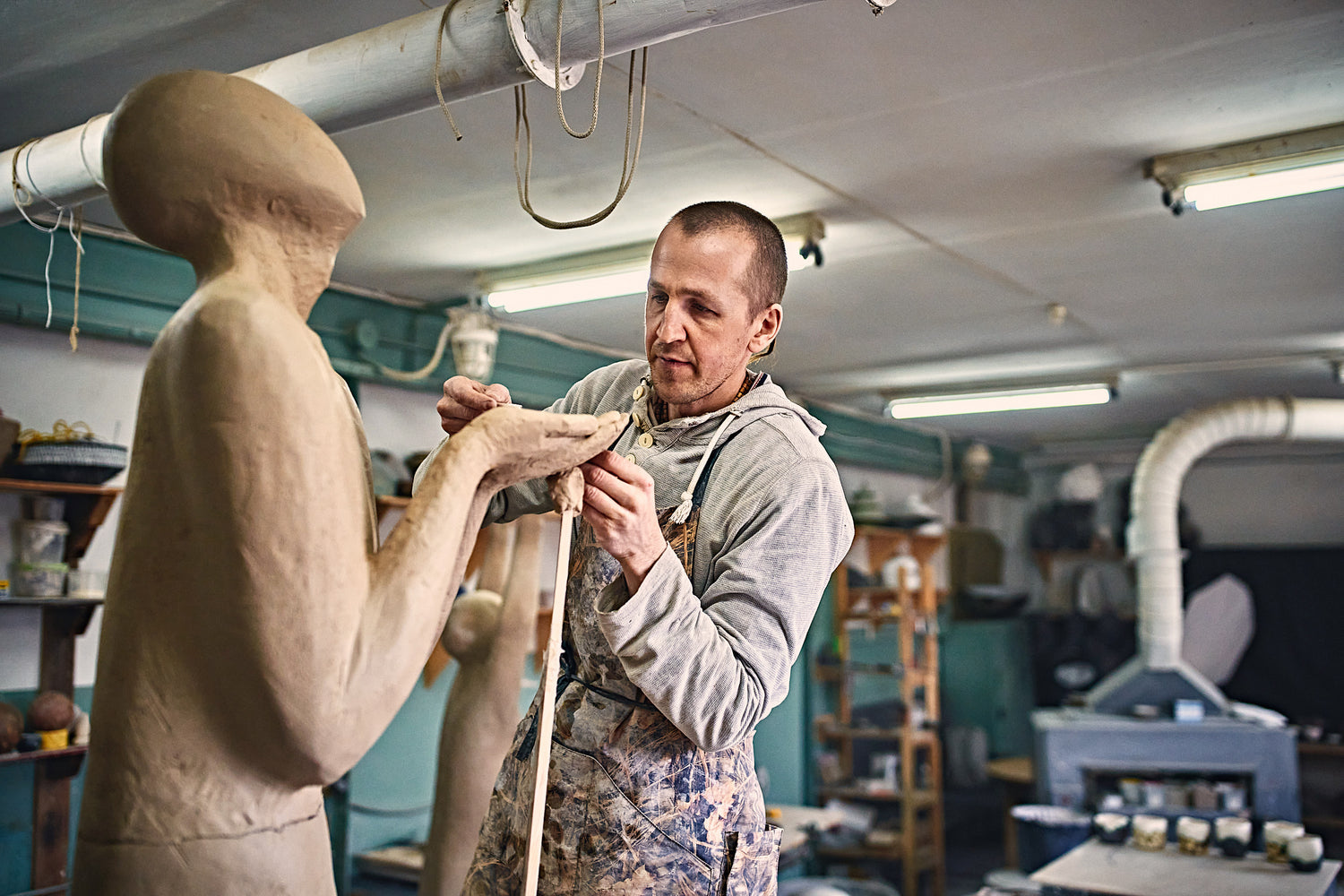
‘For me, clay is a material that makes you alive’
-
Born in the capital city of Opishnya, known as the ‘ceramics’ capital of Ukraine Yuriy Myrko is a second-generation ceramist. After graduating from university with a degree in ‘Fine arts and crafts’, he initially worked in a ceramics factory before setting up a workshop in his hometown.
Aside from being an important part of his ancestry, working with clay represents more than just an income and a trade. It is an integral part of his DNA. For Yuriy working with clay is a way of connecting with the soil and in so doing tapping into the forces of nature that venture into a higher consciousness. Leaning into this natural energy, Yuriy approaches his art as a sacred journey.
When his hands are directly connected to the earth, he feels the vibration and by working in synch with the earth’s natural rhythms, he can manifest that crude energy into his creations. It is a form of spiritual evolution in favour of conscious design. As a practising Krishnaite, Yuriy uses his craft as a way of serving and worshipping God as a divine being and it is that belief that takes his work from the realms of the ordinary into something quite extraordinary. -
‘In all living organisms created by nature, you can clearly trace a certain regularity, it is a natural rhythm in their structure that unites them all’.
-
No wonder then that his collections of vases, home décor and art objects so expertly mimic the shapes, forms and textures found in nature or religious deities as a bridge to a greater realm.
-
Bogdan Kryvosheya is the commercial business brains behind the company. After graduating with a degree in Business Management from Queen Mary University of London, he gained valuable business acumen and went on to pursue his passions for music, fashion and design, organising music festivals and events including the festival of dissociative art ‘That’s Wassup’.
-
Following Yuriy’s move to Kyiv, the two crossed paths and established a mutual connection. Agreeing to combine their skills, they founded Gorn Ceramics in 2018 with Bogdan as Creative Director. Sharing Yuriy’s philosophy, Bogdan is keen to explore the connection between spiritualism and ceramics whilst developing new and exciting avenues to expand the business.
-
Paying homage to their profound beliefs, they created the Temples and Pagodas Collections
-
Tuning into the natural rhythms and cycles of nature, the Temples collection comprises vases with varying height and colour, characterised by a series of uniformed ridges. The taller ones rise majestically into the sky, confidently asserting their stature whilst reaching for higher realms. To capture the relationship between the maker and his materials, glazing and artificial materials are excluded, allowing the imprint of fingers to immortalise the surface of the clay.
-
Celebrating raw beauty, the surface of each vase is scored with millions of tiny indentations creating undulating textures that traverse the exterior. Organic shapes celebrate free-flowing movement in a style reminiscent of Gaudi, the renowned sculptor, famous for the creation of the Sagrada Família in Barcelona. Gaudi’s distinctive style, recognised the world over, embodies the same natural influences, luscious curves and textures that have become his crowning trademark. Reflecting the great outdoors, the vessels are available in colours of scorched earth, desert sand and muddy pools with an uneven colour distribution that feels authentic. Photographed and videoed in their natural habitat, they blend seamlessly with their surroundings like perfect camouflage.
-
The exterior of each sculpture leaves millions of the creator's fingerprints, as a documentation of his unique "dance" with the surface. The form that fills up the void with meaningful purpose.
-
The Pagoda Collection as the name suggests is influenced by Hindu, Buddhist and Taoist temples found in parts of Asia and India. Characterised by a series of tapered eaves, each one slightly smaller than its predecessor, their structure can vary in both size and scale. Traditional pagodas were made using bamboo, a naturally growing material. Associated with luck, they evoke a sense of deep serenity rich in cultural heritage. Their geometric form belies their traditional roots, creating a distinctly contemporary feel.
-
Great care and precision have gone into creating angular lines that replicate the symmetrical layers of the supremely peaceful pagoda. Available in a kaleidoscope of colours and patinas, the artist skilfully depicts the effect of refracted light which dances like shadows across the vases as if filtered through the lens of the natural forest. Additional colours include mossy greens, shimmering bronzes and stoney greys.
-
A new collection of sculptures named ‘Souls’ embodies the form of animals including the White Elephant, Cow and Rhino alongside cattle and sheep with their distinctive and magnificent form and character. With a texture that resembles parched earth, their perfectly blended palettes include khaki green, terracotta, and muddy grey alongside earthy brown, which balance well with natural fabrics found in the home. White ivory perfectly depicts the majestic elephant. The rustic undulating texture gives the sculpture a vintage aesthetic that is timeless and can be paired with contemporary furniture to inject character.
The idea behind the collection was to capture the spirit of the incarnated soul embodied in animals. To appreciate this is to gain a deep level of mutual respect and love for all living creatures, which is the driving force behind his creations. -
‘Every living creature, especially an animal, is an incarnation of the soul in a material body’
Shishka collection
-
The connection to nature is also embodied in Gorn Ceramic’s floral, woodland and plant collections which each hold unique meaning and symbolism.
-
The Shishka collection takes its name from the conifer cone, which in Ukrainian culture represents a combination of hard work and success and in other parts of the world symbolises life. Like the Temples collection, the artist chooses to celebrate the beauty of the natural texture, to expose the fingerprints and marks of the sculptor giving the exterior a rough timeworn feel that resembles stone, in the shape of a conifer. With a choice of colourways, the vases are available in a prism of natural hues that perfectly reflect their surroundings. Others resemble weathered oxidised copper or reflect the changing seasons with tones of icy blues and white.
Makyvky collection
-
The Harbuzi vases follow the form of the voluptuous pumpkin with all its curvaceous lines and lush ample forms which combine to create delightfully unusual vases with a naturally organic appeal.
-
The Makyvky collection is inspired by both the poppy seed and the lotus flower. This artful representation skilfully depicts the bulbous head and carefully outturned petals. Symbolising all stages of life from fertility through to death, the poppy seeds have a deep spiritual connotation. Due to its ability to prosper in dark and gloomy conditions, the lotus flower is associated with resilience. In Hindu religion they represent ‘the womb of the universe from which all things are born’
-
I hope you’ve enjoyed this fascinating insight into the spiritual realms of Gorn Ceramics and their close relationship with the natural world. Discover more of their collections including their Flora, Corals and Flame collections alongside their decorative tiles and wall art.
-
The USAID Competitive Economy Program in Ukraine (USAID CEP) supports startups, small and medium enterprises (SMEs) aiming to provide support for competitive industries and firms on Ukrainian and international markets, foster a better business-enabling environment and enable Ukrainian companies to benefit from international trade.
Harbuzi collection
The items used in the project
-
Ceramic Vase White Makyvka
Regular price From £253.00 GBPRegular priceUnit price per -
Ceramic Vase Harbuz
Regular price £506.00 GBPRegular priceUnit price per -
Ceramic Vase Pagoda dry
Regular price £759.00 GBPRegular priceUnit price per -
Ceramic Vase Earth Corals
Regular price £337.00 GBPRegular priceUnit price per


















